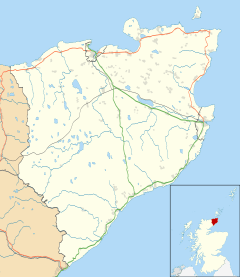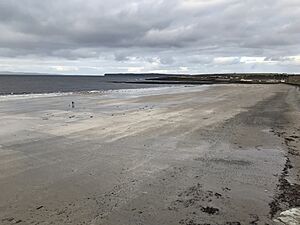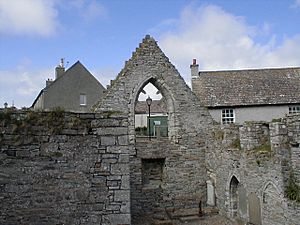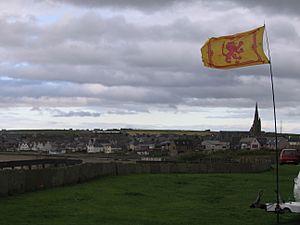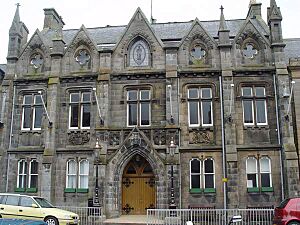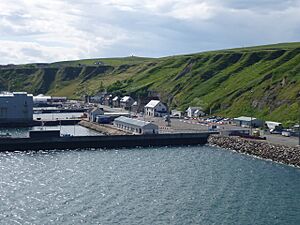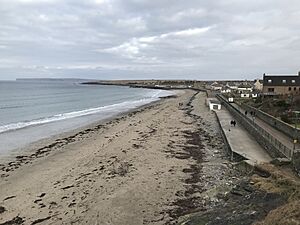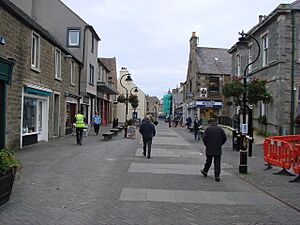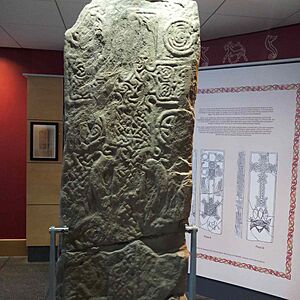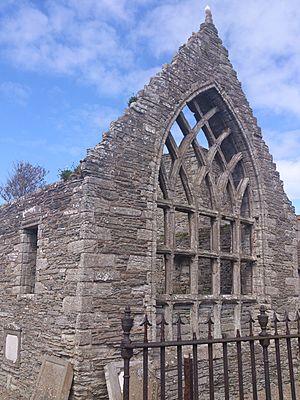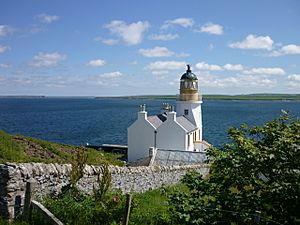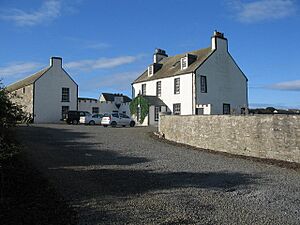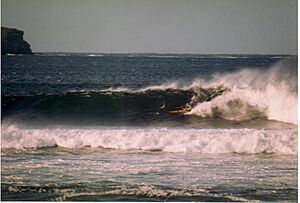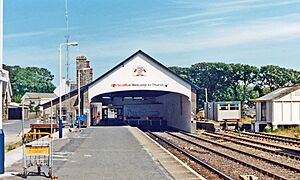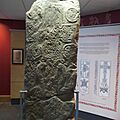Thurso facts for kids
Quick facts for kids Thurso
|
|
|---|---|
| Town | |
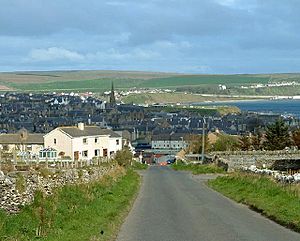 |
|
| Population | 7,390 (2020) |
| OS grid reference | ND115685 |
| • Edinburgh | 183 mi (295 km) |
| • London | 508 mi (818 km) |
| Council area | |
| Lieutenancy area | |
| Country | Scotland |
| Sovereign state | United Kingdom |
| Post town | Thurso |
| Postcode district | KW14 |
| Dialling code | 01847 |
| Police | Northern |
| Fire | Highlands and Islands |
| Ambulance | Scottish |
| EU Parliament | Scotland |
| UK Parliament |
|
| Scottish Parliament |
|
Thurso is a town located on the north coast of Scotland. It's part of the Highland council area. This town is the most northern town on the island of Great Britain. It is even further north than the southernmost part of Norway! Thurso is also more than 500 miles (800 km) north of London.
Thurso sits where the main north-south road (the A9) meets the west-east road (the A836 road). It connects to Bridge of Forss in the west and Castletown in the east. The River Thurso, which is 34 miles (55 km) long, flows through the town. It then empties into Thurso Bay and the Pentland Firth. The river's mouth acts as a small harbor. In 2011, Thurso had about 7,933 people living there.
Thurso was once an important port for the Norse people. Later, it traded with many ports across northern Europe until the 1800s. It was also a busy fishing center. Thurso was known for making linen cloth and for tanning leather. Today, the Dounreay Nuclear Research Establishment is a major employer. Even though it's mostly closed down, it still provides many jobs for local people.
The ruined Old St Peter's Church is one of Scotland's oldest churches. It dates back to at least 1125. The church used today, St Andrew's and St Peter's, was built in 1832. It was designed by William Burn in a Gothic style.
Thurso is home to the main campus of North Highland College. It also has Thurso High School, which is the most northern secondary school on the British mainland. The school opened in 1958. Thurso Castle, built in 1872, is now in ruins. Thurso has a football team called Thurso FC, started in 1998. They play in the North Caledonian League. There are also rugby teams, Caithness Crushers and Caithness RFC.
Thurso railway station opened in 1874. It is the most northern train station in the United Kingdom. The nearby port of Scrabster offers ferry services to the Orkney Islands. The NorthLink ferry, called MV Hamnavoe, travels between Scrabster and Stromness.
Contents
- What's in a Name? The History of Thurso's Name
- Thurso's Past: A Look Back in Time
- Thurso's Location and Natural Beauty
- Thurso's Economy: How People Make a Living
- Cool Places to See in Thurso
- Learning in Thurso: Schools and Colleges
- Sports and Fun in Thurso
- Getting Around: Transport in Thurso
- Thurso's Twin Town
- Famous People from Thurso
- Images for kids
- See also
What's in a Name? The History of Thurso's Name
Originally, Thurso was known by a Celtic name, tarvodubron. This name meant "bull water" or "bull river." The nearby Dunnet Head was called tarvedunum, meaning "bull fort." So, the town's name might come from these old words.
Later, the Norse people influenced the name. They called it Thjorsá, which changed to Thorsá. This name comes from the Norse god Thor and means "Thor's River."
The local Scots name, Thursa, also comes from the Norse name. The modern Scottish Gaelic name is Inbhir Theòrsa. The word Inbhir means a river mouth. You can often see it as Inver in many English place names.
Thurso's Past: A Look Back in Time
Thurso's history goes back to when the Norse people ruled Caithness. This rule ended in 1266. Very old burial sites, called Neolithic horned cairns, have been found on Shebster Hill nearby. These sites are about 5,000 years old. Thurso was an important Norse port. It traded with ports across northern Europe until the 1800s.
In 1330, King David II of Scotland made Thurso's unit of weight the standard for all of Scotland. This shows how important the town was for trade. Old St Peter's Kirk is thought to be from around 1220.
In 1811, the area had 592 houses and 3,462 people. By 1841, the population had gone down to 2,510. A large building called a poorhouse was built between 1854 and 1856. It could hold 149 people and helped those in need from Thurso and nearby areas.
Much of Thurso was planned and built in the 1800s. In 1906, a new boathouse for the Royal National Lifeboat Institution opened near Scrabster Harbour. A fire destroyed it in 1956, but a new one was built quickly. A new lifeboat, "The Three Sisters," was launched in 1971 by the Queen Mother.
A big change happened in the mid-1900s when the Dounreay nuclear power plant was built in 1955. It is about 9 miles (14 km) west of Thurso. Many workers moved to Thurso for the power station. This caused the town's population to grow from 3,000 in 1951 to 9,000 by 1971. About 1,700 new homes were built in Thurso and nearby Castletown. The power plant was mostly closed down at the end of the 1900s. However, it will still provide jobs until the 2070s as the site is cleaned up.
Thurso also gives its name to a special title, Viscount Thurso, held by the Sinclair family. In 2010, Thurso hosted the Royal National Mòd. This is a big festival of Gaelic language and culture. It was the first time the festival had been held so far north.
How Thurso is Governed
Thurso has been a special type of town called a burgh of barony since 1633. The town council used to meet at Thurso Town Hall from 1870. In 1975, Thurso became part of the Caithness district. Then, in 1996, it became part of the larger Highland council area.
Since 2017, Thurso has been part of a larger area called the Thurso and Northwest Caithness ward. This ward elects four local councillors. These councillors help make decisions for the area. The current councillors are Matthew Reiss, Struan Mackie, Ron Gunn, and Karl Rosie.
Thurso also has a Community Council. This council helps represent the local people and gives them a voice in local matters.
Thurso's Location and Natural Beauty
Thurso is the most northern town on the British mainland. It sits on the coast and looks out towards the Orkney Islands. It is at the very end of the A9 road, which is the main road connecting Caithness to the south of Scotland. Thurso is about 19.5 miles (31.4 km) west of John o' Groats. It is also 20.4 miles (32.8 km) northwest of Wick, the closest town.
Thurso railway station is the most northern point on Britain's train network. It connects Thurso directly to Wick and to Inverness. Thurso is surrounded by other areas like Olrig and Bower to the east, Halkirk to the south, and Reay to the west. It stretches from Holborn Head and Crosskirk Bay in the west to Dunnet Head and Dunnet Bay in the east. Thurso is slightly further north than Juneau, the capital of Alaska!
The 34-mile (55 km) long River Thurso is famous for its salmon fishing. It flows through the town and into Thurso Bay and the Pentland Firth. The river's mouth acts as a small harbor. Thurso has a nice harbor and beach. From here, you can see the Pentland Firth and the Orkney island of Hoy. You can also see the tall rock stack called the Old Man of Hoy.
Thurso's Weather
Thurso has a cool oceanic climate. This means its weather is similar to the Scottish Highlands. The highest temperature ever recorded was 25°C (77°F) in July 1995. The lowest was -11°C (12°F) in December 2010. Even though Thurso is mild enough for trees to grow, the windy surroundings are mostly grasslands. These look like the nearby Orkney and Shetland islands. The sea stays cool even in summer, and its temperature doesn't change much all year.
| Climate data for Thurso, Scotland | |||||||||||||
|---|---|---|---|---|---|---|---|---|---|---|---|---|---|
| Month | Jan | Feb | Mar | Apr | May | Jun | Jul | Aug | Sep | Oct | Nov | Dec | Year |
| Record high °C (°F) | 14.1 (57.4) |
14.4 (57.9) |
17.8 (64.0) |
19.8 (67.6) |
22.8 (73.0) |
24.3 (75.7) |
25.0 (77.0) |
24.9 (76.8) |
23.0 (73.4) |
19.9 (67.8) |
16.2 (61.2) |
13.8 (56.8) |
25.0 (77.0) |
| Mean daily maximum °C (°F) | 6.2 (43.2) |
6.6 (43.9) |
8.0 (46.4) |
10.2 (50.4) |
12.7 (54.9) |
14.6 (58.3) |
16.6 (61.9) |
16.6 (61.9) |
14.6 (58.3) |
11.6 (52.9) |
8.5 (47.3) |
6.6 (43.9) |
11.1 (52.0) |
| Mean daily minimum °C (°F) | 0.8 (33.4) |
0.8 (33.4) |
1.7 (35.1) |
3.2 (37.8) |
5.2 (41.4) |
8.1 (46.6) |
10.1 (50.2) |
10.2 (50.4) |
8.2 (46.8) |
5.8 (42.4) |
3.2 (37.8) |
1.1 (34.0) |
4.9 (40.8) |
| Record low °C (°F) | −10.6 (12.9) |
−10.0 (14.0) |
−7.8 (18.0) |
−5.3 (22.5) |
−2.6 (27.3) |
−0.9 (30.4) |
1.2 (34.2) |
0.6 (33.1) |
−3.4 (25.9) |
−6.2 (20.8) |
−8.8 (16.2) |
−11.0 (12.2) |
−11.0 (12.2) |
| Average precipitation mm (inches) | 100.4 (3.95) |
79.4 (3.13) |
82.3 (3.24) |
58.0 (2.28) |
55.3 (2.18) |
63.7 (2.51) |
70.5 (2.78) |
76.3 (3.00) |
96.8 (3.81) |
104.0 (4.09) |
115.5 (4.55) |
110.4 (4.35) |
1,002.4 (39.46) |
| Mean monthly sunshine hours | 36.6 | 67.9 | 96.4 | 145.3 | 196.3 | 157.3 | 140.9 | 135.2 | 114.1 | 76.2 | 45.7 | 28.7 | 1,240.5 |
Thurso's Economy: How People Make a Living
In the past, Thurso was known for making linen cloth and for its busy tanning business. Fishing has always been very important to the local economy. The Thurso Shipowner's Association managed much of the shipping. The port of Scrabster is about 1.5 miles (2.4 km) west of the River Thurso's mouth. It plays a big part in Scotland's white fish industry. Scrabster has deep water and is protected by Holborn Head.
The harbor has a dock for the MV Hamnavoe ferry. This ferry, run by Northlink, connects the Scottish mainland to Stromness on Orkney. There is also a large fish market and the local lifeboat station.
Thurso has a small museum called the North Coast Visitor Centre. It also has several hotels, bars, a surf shop/cafe, and a small skatepark. There is a large British Telecom call center in town. A factory that makes special batteries for the MoD is on the west side of town. These, along with the Dounreay Nuclear power plant, provide many jobs in Caithness. In 2010, a wind farm called Baillie was approved near Thurso. It has 21 wind turbines and can power 25,000 homes.
Cool Places to See in Thurso
The ruined Old St Peter's Church (St. Peter's Kirk) is a very old church in Scotland. It dates back to at least 1125. It was once the main church for the area.
The church used today, St Andrew's and St Peter's, was built in 1832. It was designed by William Burn in a Gothic style. The pipe organ was added in 1914. Some of the beautiful stained glass windows were added in 1922.
Holburn Head Lighthouse, located nearby, was finished in 1862. It was designed by David and Thomas Stevenson.
The Swanson Gallery in Thurso has art exhibitions all year. It shows glass art by Ian Pearson. The North Coast Visitor Centre also has exhibitions. Some notable hotels include the Royal Hotel, Pentland Hotel, and Forss House Hotel.
In Sir John's Square, there is a garden and a statue. This was given to the town by Sir Tollemache Sinclair. It honors his grandfather, Sir John Sinclair. He was important for creating the first detailed report of Scotland and for improving farming in Caithness. A fountain was built in 1894 by Sir George Sinclair's son. Also, the wellhouse of Meadow Well was the main water source for Thurso for centuries. The current well, with its cone-shaped roof, was finished in 1823.
The war memorial in Thurso was built in 1922 and designed by Percy Portsmouth.
Learning in Thurso: Schools and Colleges
The main campus of North Highland College is in Thurso. It is part of the University of the Highlands & Islands. The college offers many courses, from Nuclear Decommissioning to Hairdressing and Golf Management. Next to the college is Thurso High School. It is the most northern secondary school on the British mainland and opened in 1958.
Thurso also has three primary schools: Pennyland, Miller Academy Primary, and Mount Pleasant. Mount Pleasant Primary School has a special unit for learning in Scottish Gaelic. This is part of an effort to bring the language back to Caithness. In 2011, about 110 people in Thurso (1.43%) spoke Gaelic. A Gaelic nursery school, Cròileagan Inbhir Theòrsa, started in 1996.
The North Coast Visitor Centre is a small museum that opened in 2021. It has displays from the control room of the Dounreay Materials Testing Reactor. This was Scotland's first working nuclear reactor in 1958.
Sports and Fun in Thurso
Thurso is a great place for surfing and kayaking because of its strong waves. International surfing events are often held here. Surfers come from all over the world. Both the European Surfing Championships and Scottish Surf Kayaking Championships have taken place in Caithness. Thurso East is the main spot for these activities. The North Coast Branch of the Coastguard Association also organizes an annual raft race.
The football team, Thurso FC (called "the Vikings"), started in 1998. They play in the North Caledonian League. Caithness Crushers are a rugby league club. Caithness RFC is a rugby union club. The local athletics club is Caithness Amateur Athletics Club (C.A.A.C.). Thurso has the biggest swimming club in the Highland area, Thurso Amateur Swimming Club (TASC), with over 250 members. Thurso Bowling Club is next to the Tesco supermarket. The Caithness Motocross Club also holds races often during the summer.
Getting Around: Transport in Thurso
Thurso railway station opened in 1874. It was the most northern station on the Sutherland and Caithness Railway. It is now part of the Far North Line.
The nearby port of Scrabster offers ferry services to the Orkney Islands. The A9 main road connects Thurso to Inverness, Perth, and other parts of Scotland. It ends at the ferry terminal. Stagecoach runs bus services from Thurso to Wick and John o' Groats. There is also a longer bus service to Helmsdale and Inverness.
Thurso's Twin Town
Thurso is twinned with Brilon, a town in Germany. This connection started in 1971 when Scout leaders from both towns met. Scouts from Brilon visited Thurso in 1972, and Thurso Scouts visited Brilon in 1973. A strong friendship grew between the Scout groups and families. In 1979, the towns officially became twin towns.
Scouts from Thurso and Brilon still meet regularly. In 2019, 60 German Scouts and 12 guests from Brilon visited Thurso to celebrate 40 years of their twinning.
Famous People from Thurso
- Andrew Geddes Bain (1797–1864) — a geologist and road engineer.
- Colin Birss (born 1964) — a British judge.
- John Charles "Jock" Campbell (1894–1942) — a British Army officer who received a very brave award, the Victoria Cross.
- Martin Carr (born 1968) — a writer and musician.
- Robert Dick (1811–1866) — a geologist who lived in Thurso.
- Bryan Gunn (born 1963) — a professional football goalkeeper and manager.
- Robin Harper (born 1940) — a politician.
- Gary Mackay-Steven (born 1990) — a professional football player.
- Anne McKevitt (born 1967) — an entrepreneur and TV personality.
- Martin Rennie (born 1975) — a professional football coach.
- Sir William Alexander Smith (1854–1914) — the person who started the Boys Brigade.
- Donald Swanson (1848–1924) — a senior police officer.
Images for kids
See also
 In Spanish: Thurso para niños
In Spanish: Thurso para niños


